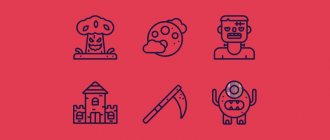Quite recently we came across some interesting material about human fears, and we found in it interesting information on this topic. Did you know, for example, that 15 to 20 percent of all people experience phobias, and about 9% of Americans over 18 have at least one specific fear? [Diagnostic and Statistical Manual of Mental Disorders, Fourth Edition Text Revision of the American Psychiatric Association].
But there are also interesting statistics for Russia. She says that over the past 10 years, the fears of Russians have changed: if recently our compatriots were afraid of being unemployed and starving, today the first lines of the “hit parade” of Russians’ fears are occupied by fears of rising prices, international conflicts and the threat of world war, and also fear of getting sick and becoming a victim of criminals. [Data from the All-Russian Center for the Study of Public Opinion].
But generally speaking, the results of recent research from Chapman University [America's Top Fears, 2015] showed that 90% of all people in the world generally experience fear from time to time, and 40% of them face problems because of this fear . And the problems, in turn, can be very different, ranging from mild psychological discomfort to depression and self-restraint, inability to achieve success in life and become happy, serious mental illness and even suicide.
Naturally, we are not talking about the fact that such far from rosy prospects await everyone. But in any case, if you want to live a full life, expand your boundaries and develop, you must definitely work through your fears. Therefore, in fact, we decided to write this material.
What is fear?
Fear is an internal sensation that reflects a defensive reaction when experiencing real or imaginary danger.
In psychology, it belongs to the group of so-called negative or negative emotions - emotions that are based on unpleasant experiences or external influences. One type of fear is a phobia. This is an irrational, poorly controlled fear of an object, living creature or being in certain external circumstances. At the same time, a person tries with all his might to avoid contact with the source of his fear, even if it does not pose any objective threat.
What happens to the body?
Fear provokes responses in the body that help you quickly escape from danger or give you strength to fight the enemy.
Breathing and heart rate increase, capillaries constrict, blood vessels around vital organs dilate, and muscles become engorged, ready to attack. Muscle tension causes goosebumps on the skin. This is how hair stands on end, and while this does not provide any advantage to humans, it helps most other animals appear larger and more menacing.
Causes of fear
Fear is a natural response to a feeling of danger; it helps to avoid getting into situations that threaten health and life.
Depending on the type of fear, these may be external circumstances or internal experiences. Most often, this emotion is caused precisely by the features of the environment - closed space, height, darkness. Less often, fear is caused by a person’s feelings about social interaction with parents, loved ones or business partners.
The limbic system of the central nervous system, mainly the left amygdala, is responsible for the development of fear. The process is implemented through two neural pathways: short and long. The first is responsible for a quick reaction to potential danger, the second controls the adequacy of the response to the trigger and supports or blocks the shortcut. When the long path is disrupted, phobias arise. A number of hormones are also involved in the formation of feelings of fear, including cortisol, the “stress hormone.”
The most common types of fears and phobias are:
- Thanatophobia is the fear of one's own death.
- Stage fright is the fear of speaking in front of a large audience.
- Cynophobia is the fear of dogs.
- Acrophobia - fear of heights.
- Nyctophobia is the fear of the dark.
- Claustrophobia is the fear of enclosed spaces.
- Agoraphobia is the fear of being in places that cannot be quickly or easily left.
- Arachnophobia is the fear of spiders.
- Aviation phobia is the fear of air travel.
- Astralophobia - fear of thunderstorms.
Types of fear
In modern psychological practice, the classification of fears according to Shcherbatykh Yu.V. is used, which includes:
- Natural or natural fears, which are a reaction to natural phenomena: lightning and thunder, earthquakes, animal aggression, etc.
- Social fears, represented by fear of responsibility, speaking in public, taking an exam, or having an important conversation.
- Internal or existential fears that are created by the person himself, for example: fear of one’s own thoughts and actions.
Children's fears are highlighted separately, including the fear of being alone, fear of other people, doctors, fairy-tale images, etc.
Every person is capable of overcoming fear.
Fear makes us anxious and apprehensive. We become more cautious, picky, suspicious, and this often interferes with enjoying life itself. You have to be constantly on your guard. The phobia becomes our internal burden, which we have to carry with us every day.
Perhaps we should try to get rid of it?
When you decide to fight your fear or phobia, remember!
- Every person has hidden forces within him to fight.
- The causes of fear lie within you, for example, some traumatic situation from childhood.
- Fear causes you to become addicted, and almost any addiction can be overcome.
Remember, you are not alone. If you want to live a calm life and get rid of the fear that interferes with your normal life. The time has come, you have already passed 50% of the way and you have very little left.
Signs of fear
Fear affects both a person’s physical condition and his behavior and well-being. Its manifestations can vary depending on the degree of potential threat from minor anxiety to panic.
State and feeling of fear
Fear is accompanied by the production of a number of hormones - adrenaline, norepinephrine and cortisol. They allow you to prepare for a response to a threat by changing the functioning of the heart, lungs and systemic metabolism.
The release of hormones puts the body in a state of heightened alert: blood supply to the muscles increases, blood glucose levels rise, and the brain concentrates only on potential danger. All this is accompanied by a number of somatic manifestations:
- Increased heart rate and breathing.
- Increased sweating.
- Dry mouth.
- Pupil dilation.
- Tunnel vision: a condition in which a person perceives visual information only about what they see directly in front of them. Peripheral vision is “turned off”.
- Inability to switch attention and thoughts to anything other than the source of fear.
- Dizziness and loss of appetite.
- General tension and increased muscle tone.
- Increased reaction speed and decreased pain sensitivity.
The mental reaction to fear varies from person to person and depends on the strength of the emotion. Often people feel only physical changes and anxiety, trying to avoid danger through their actions. With a sharp, sudden impact, a state of numbness and the inability to do anything is possible.
A short-term feeling of fear is harmless. However, with a long stay in this state, negative consequences are formed, such as:
- Sleep disturbance, insomnia.
- Decreased libido.
- Excessive irritability, aggressiveness.
- Frequent headaches.
- Decreased performance and loss of planning skills.
Why do people strive to experience fear?
The emotional response to fear is very individual and is often experienced differently by people.
Fear can also cause positive reactions in the human central nervous system. In some situations, the feeling of fear is regarded as entertainment, for example, while watching horror films. There are also people who provoke a feeling of fear in themselves - the so-called adrenaline junkies. Most often, these are people who are interested in extreme sports and other activities associated with risks to health and life.
Panic fear
Sometimes fear goes beyond the boundaries of a physiological reaction and becomes excessively strong, and a person goes into a state of panic, losing control over himself and the situation. If the reason for the appearance of such strong fear cannot be established, we are talking about a panic attack.
A panic attack is accompanied by extremely unpleasant sensations. Photo by Alex Green: Pexels
Panic attacks are often preceded by physical and emotional overload, and less often by sudden changes in hormonal levels. They are most often associated with the following factors:
- Chronic stress.
- Severe emotional shock.
- Long periods of sleep deprivation.
- Excessive physical activity.
- Severe somatic diseases, for example cancer.
- Pregnancy.
Panic attacks can also be a symptom of mental disorders, including: depression, psychopathy, hypochondria, schizophrenia, obsessive-compulsive disorder.
With panic fear, unlike its other types, symptoms may occur that resemble somatic diseases. Quite often this emotion is accompanied by:
- Feeling of chest pain.
- Shortness of breath, difficulty breathing.
- Feeling of numbness in the limbs.
- Fuzzy, clouded consciousness.
- Loss of consciousness.
Panic attacks last from several minutes to 1-2 hours, on average - about 30 minutes. They are also characterized by frequency, which can vary from 1-2 attacks per month to several per day.
Fear of pain
Algophobia or fear of physical pain is one of the common fears, which is often associated with previously experienced severe pain. In everyday life, it manifests itself when visiting medical institutions and dental offices.
Algophobia is common in children. Photo: FanMU/Depositphotos
Normally, a person tries to avoid harm to his health, which is often accompanied by pain. With algophobia, even the potential opportunity to feel pain causes strong fear with all its manifestations. An example is the fear of donating blood for laboratory tests due to the pain that is accompanied by puncture of the skin with a scarifier or syringe needle.
Fear of Rejection
Another fairly common fear is the fear of being rejected by society or a specific person. As a rule, it is formed against the background of a previous experience of a painful break with a person or rejection, for example, in a family. There is also a hypothesis that it is associated with autism spectrum disorders (autism, Asperger's syndrome) and attention deficit hyperactivity disorder (ADHD).
Negative experiences in the past can cause fear of being rejected by people. Photo by RODNAE Productions: Pexels
The fear of rejection is especially sensitive to interactions with other people:
- Constantly expecting the relationship to deteriorate and preparing for it.
- A persistent feeling of disrespect, ridicule and criticism addressed to you.
- An overly strong reaction to breaking up a relationship with someone. In this case, the response can be either severe aggression or depression.
Fear of getting coronavirus
The fear of infection with COVID-19 has become relevant today.
There is an opinion that it is based on the so-called “behavioral immune system,” which is behavioral characteristics aimed at minimizing the risk of getting a dangerous disease. The behavioral immune system evolved during a time when humans did not yet have such effective drugs to fight infections. This fear is fueled by constant news in the media about the number of new cases and deaths from this disease, the general mood in society and the understanding that effective drugs against the SARS-CoV-2 coronavirus have not yet been found.
When to see a doctor?
Fear is not always useful, and in some cases it is recommended to seek help from a specialist. Reasons for seeking medical help may include:
- Panic attacks, especially those that occur for no apparent reason.
- Inability to engage in work or household activities and other daily activities due to fear and phobias.
- Constantly being in a state of fear for no apparent reason.
- Severe deterioration in physical condition due to fear.
- The appearance of fear against the background of other somatic (for example, bronchial asthma) or mental (schizophrenia) diseases.
- Sleep disorders.
If you have phobias, fears of specific things or circumstances, you should seek help from a psychologist or psychotherapist. It is also recommended to consult a specialist in this profile if you have groundless but controllable fears.
Before visiting a doctor, certain preparation and analysis of your condition is recommended. They will simplify the process of diagnosis and choice of treatment tactics. It is useful to prepare the following data in advance:
- All the symptoms that accompany the feeling of fear, even if they seem unrelated to the emotions experienced.
- Triggers are things, people, factors or external circumstances that provoke feelings of fear and anxiety.
- Reactions and methods of counteracting fears and phobias, including the results of their use.
- Previously experienced severe emotional shocks or stressful periods.
- A list of all medications, nutritional supplements and vitamins that are taken, as well as their doses.
Treatment of fears
Treatment and combating pathological forms of fear may include both psychological techniques and drug support. The goal of the therapy is to reduce the frequency of unreasonable attacks of fear and their severity, as well as to prevent negative consequences for the body and control phobias.
Cognitive behavioral therapy
This is one of the options for conversational psychotherapy, which involves searching, analyzing and working through a person’s thoughts and beliefs that potentially cause fears and underlie phobias. This therapy is based on reinforcing the desired types and characteristics of behavior, which entails a change in emotions and thinking, leading to the development of fears.
Over the course of a series of sessions, the psychotherapist helps to respond in a structured manner to situations and factors that cause feelings of fear and to respond to them more effectively. The number of visits to the doctor can vary from 5 to 20 depending on the severity of symptoms, support from others and personal progress.
Group classes
An effective approach to treating fears is group therapy, in which people with similar problems communicate. It is believed that getting to know the stories of others, especially if they have successfully confronted their phobias and have already achieved certain results, helps to better deal with personal experiences. It also allows you to get new advice and learn about new treatment tactics and choose the most suitable option for yourself.
Group classes help to cope with fears. Photo: PsychotherapyNet / YouTube
Drug treatment
Psychotherapeutic approaches are considered the most effective. Drug treatment is used for severe symptoms of anxiety and fear that cannot be overcome by other means.
Depending on the person’s condition and associated factors, medications can be prescribed either as a short course at the beginning of therapy or on an ongoing basis. To combat the feeling of fear and its consequences, the following groups of medications are used:
- β-blockers. These are medications that block the effects of hormones on the body that are released during the experience of fear.
- Tranquilizers, mainly benzodiazepines. Directly suppresses anxiety and fear. At the same time, they can be addictive and are not recommended for use in cases of alcohol and drug addiction.
When phobias and fears appear against the background of psychiatric diseases, sleeping pills, antipsychotics and antidepressants can also be used. However, such funds should not be used by a person independently - they are prescribed only by a competent specialist after a comprehensive examination.
Devices for measuring the level and strength of fear.
In the process of the development of science, scientists received various devices with the help of which it became possible to carry out psychophysiological diagnostics of a person. At the beginning of the 19th century, the French doctor S. Feret and the Russian physiologist Tarkhanov independently discovered that when fear occurs in human skin, its electrical properties change. This is how the galvanic skin response (GSR) was discovered, which is the most informative component of a polygraph (lie detector). Thanks to GSR, you can measure the level of fear.
Today, the polygraph is one of the most accurate instruments that can be used to measure the body's reaction to a stimulus, which can be either dangerous or non-dangerous.
How to get rid of fear?
You can start confronting your fears and phobias on your own. For this purpose, a number of tips and recommendations have been developed. However, you should not expect quick results - it is a long journey that always starts small.
AWARE technology
One of the effective ways to get rid of fear is to study and accept it. For this purpose, a special AWARE (awareness) technique is used. This acronym stands for:
- Accept - recognition. Acceptance of your fear, a kind of recognition to yourself. Often, already at this stage, a person’s quality of life improves significantly.
- Watch - observation for the purpose of which you can keep a so-called “alarm diary”. It should record all thoughts and sensations that accompany the episode of fear, factors and situations that provoke or aggravate it.
- Act - action. Control of behavior, it should be as if everything is normal, even if fear is present. For example, you should continue to go to the place that causes unreasonable fear. This helps suppress an overly emotional response.
- Repeat - repetition. The previous points should be repeated on a regular basis, even if the first attempts seem unsuccessful.
- Expect - expectation. Confidence in your abilities and the fact that fear can be controlled gives you even more self-confidence and helps you master your phobias.
Proper nutrition
High blood glucose levels are associated with increased feelings of anxiety. Therefore, you should avoid large amounts of carbohydrate foods in your diet, giving preference to fresh fruits and vegetables.
It is also recommended to limit the consumption of strong tea and coffee, as they are rich in caffeine, which can increase the level of emotional arousal and anxiety.
Quitting alcohol and smoking
Despite the popular habit of drinking and smoking “for courage,” alcoholic drinks and tobacco products increase the level of arousal of the nervous system, thereby increasing anxiety and fear.
Sports activities
Sports and exercise force a person to concentrate, which allows him to take his mind off fears and worries. Also, being in good physical shape gives additional self-confidence, which helps in the fight against internal worries.
Relaxation
One of the simplest approaches to counteracting fear is relaxation techniques. Even a simple deep breath and exit helps you gather yourself and take control of the situation. You can also try to imagine yourself in a pleasant, relaxing place.
Listening to your favorite music helps many people. In the long term, massage, yoga, tai chi and meditation can be effective.
Christian attitude to fear according to the teachings of the Holy Fathers
Cowardice, that is, experiencing fear of people, or demons, or any events in life that happen or may happen in the future, is a sign of the spiritual illness of a Christian who should not experience fear of anything like that. According to the testimony of St. Isaac the Syrian, “a fearful person makes it known that he suffers from two ailments, that is, love of life and lack of faith. And love of life is a sign of unbelief.”5
The Lord Himself pointed out the connection between fear and lack of faith when He said to the apostles, who were afraid of the storm: Why are you so fearful, you of little faith?
"(Matt.
8
, 26).
This organic connection between timidity and lack of faith is well explained by St. Nicholas of Serbia: “Tearful people have a heart that is too earthy and therefore petrified. The Word of God grows best in external storms and winds, like mountain pines. But the fearful, having joyfully accepted the word of God, is afraid of storms and winds and falls away from the word of God, rejects it and again cleaves to his land. The earth bears fruit quickly, but we must wait for the fruits of God’s word. At the same time, the fearful one is tormented by doubt: “If I miss these earthly fruits that I hold in my hands, then who knows whether I will wait and taste the fruits promised to me by the word of God?” And so the fearful will doubt God and believe in the earth; will doubt the truth and believe in lies. And faith, without taking root in his petrified heart, disappears, and the word of God, sown on stone, returns to its Sower.”6
The Monk Nikon of Optina conveys the instruction of the Monk Barsanuphius of Optina as follows: “You only need to be afraid of sins... But the Holy Scripture says that God does not love the fearful. No one should be fearful or cowardly, but should place their hope in God. Why does God not love the fearful, the cowardly? Because they are close to despondency and despair, and these are mortal sins. A timid and coward is on the edge of an abyss. A true monk must be alien to such a dispensation.”7
St. John Climacus defines timidity as “the daughter of unbelief and the offspring of vanity”8, and points out that this is a sinful passion that stems from the passion of pride: “The proud soul is a slave of fear; trusting in herself, she is afraid of the faint sound of creatures and the very shadows.”9
The Monk Nile of Sinai testifies to the same thing, commanding: “Do not betray your soul to pride, and you will not see terrible dreams, because the soul of a proud person is abandoned by God and becomes the delight of demons. A proud person imagines many attacking animals at night, and during the day he is embarrassed by fearful thoughts; if he sleeps, he often jumps up and, while awake, is afraid of the bird's shadow. The noise of a leaf terrifies the proud one, and the murmur of water strikes his soul. For the one who recently resisted God and renounced His help subsequently becomes afraid of insignificant ghosts.”10
The Monk Simeon the New Theologian also points out the connection between timidity and despondency: “Despondency and bodily heaviness, which appear in the soul from laziness and negligence... bring darkness and despair to the mind, which is why thoughts of timidity and blasphemy dominate in the heart”11, “the demon of timidity accompanies the demon of despondency and attacks with him, and he helps him and grabs [the victim], and the first instills fear with callousness in the soul, while the second produces darkness and relaxation in the soul and mind, as well as petrification and despair”12.
Saint John Chrysostom says that “sin... makes a person fearful and timid; but the truth produces the opposite effect”13, and St. Nicholas of Serbia points out: “Gluttony makes a person sad and fearful, and fasting makes a person joyful and brave”14.
According to the testimony of Saint Simeon, the struggle with fear is the usual state of a monk who is at the beginning or middle of the spiritual path: “Whoever has acquired a pure heart has conquered timidity, and whoever is still purifying himself sometimes overcomes it, sometimes he is overcome by it. He who does not fight at all is either completely insensitive and a friend of passions and demons..., or he is a slave of timidity, subject to it, trembling like a child in his mind, and afraid of fear where there is no fear (Ps. 13
, 5), nor fear for those who fear the Lord"15.
The Monk John notes that monks living in communal monasteries are less likely to have this passion than hermits16.
He also offers the following ways for a monk to combat timidity: “Don’t be lazy at midnight to come to those places where you are afraid to be. If you yield even a little to this infantile and laughter-worthy passion, then it will grow old with you. But when you go to those places, arm yourself with prayer; when you come, spread out your hands and beat the adversaries in the name of Jesus; for there is no strongest weapon, neither in heaven nor on earth”17; “You cannot satiate your belly in one minute; So you can’t overcome fearfulness quickly. As our crying [about sins] intensifies, it moves away from us; and with its decrease it increases in us”18; “If we, out of contrition of heart, with devotion to God, diligently expect from Him all kinds of unforeseen cases, then we have truly freed ourselves from timidity.”19
And here is what the Monk Simeon the New Theologian recommends: “Do not be surprised if, when timidity dominates you, you tremble, afraid of everything, for you are still imperfect and weak and, like a baby, you are afraid of monsters. For timidity is the infantile and laughable passion of a vain soul. Do not want to speak words with this demon or contradict him, for when the soul is in trembling and confusion, words do not help. Leave them, humble your mind as much as you can, and soon you will understand that timidity has disappeared.”20
Many holy fathers warned that the ascetic is often attacked by demons, trying to frighten him and instill “insurance.” St. Athanasius the Great conveys the instruction of St. Anthony the Great on this: “As the demons find us when they come to us, so they themselves become in relation to us... Therefore, if they find us fearful and embarrassed, they immediately attack, like robbers who have found an unguarded place , and what we think in ourselves, we produce in a larger form. If they see us as fearful and fearful, then they increase the fear even more with ghosts and threats, and finally the poor soul is tormented by this. But if they find us rejoicing in the Lord... and reasoning that everything is in the hand of the Lord, that the demon is not able to overcome a Christian and has no power over anyone at all, then, seeing the soul supported by such thoughts, the demons turn back with shame... The soul constantly let him rejoice in hope; and we will see that the demonic games are the same as smoke, that the demons would rather run away than pursue us, because they are extremely fearful, waiting for the fire prepared for them... and they especially fear the sign of the cross of the Lord.”21
The advice of St. Paisius Velichkovsky lies in the same vein: “If anyone is fearful, then do not be embarrassed at all, but be courageous and place your trust in God and do not pay attention to embarrassment at all. Do not allow this childish mood to take root in you... but consider it as nothing, as demonic. The servant of God fears only his Master, Who created the body, put the soul into it and revived it; demons, without God’s permission, cannot harm us, but only frighten us and threaten us with dreams... be courageous, and let your heart be strengthened, and protect yourself with the sign of the cross when you find insurance. Fence the place where you will enter with the sign of the cross... cross yourself and, having said a prayer and saying: “Amen,” enter boldly. If the demons find that we are steadfast in the Lord, they are immediately put to shame and do not embarrass us. Let us keep in mind that we are in the hand of God. The Lord said: Behold, I give you power to tread on the snake, and on the scorpion, and on all the power of the enemy: and nothing will harm you.
(Luke 10:19).
Let us keep in mind that without the command of God not the power of our head will perish
(Luke 21:18). We inflict insurance on ourselves with a fearful thought... let us think that God is at our right hand, and we do not move. Demons watch us like fishers and carefully watch our thoughts; as we are in our thoughts, similar ones present us with their dreams. But the fear of God casts out the fear of demons.”22











